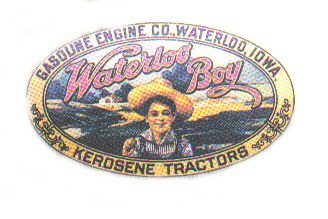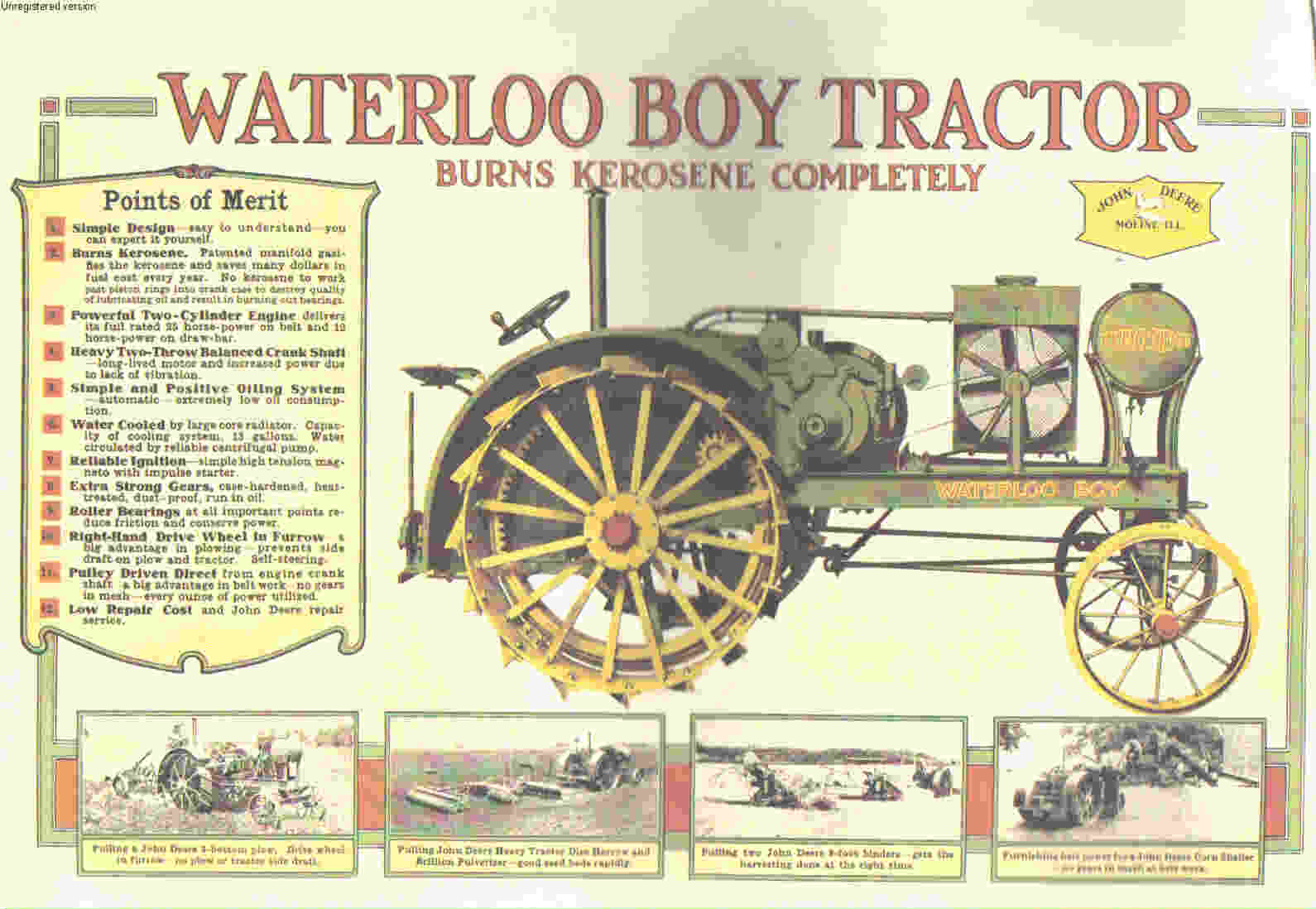The beginnings of
the Waterloo Boy
Tractor
|
|

The Waterloo Boy Tractors
Model N 1916 to 1924
Anything that can be done on the farm by horses, can be accomplished
by the Waterloo Boy Tractor, at least that's what the Waterloo
Tractor literature read.
The Waterloo Boy tractors had a water cooled, two cylinder engine
that burned kerosene, a cheaper fuel for farmers to purchase. The
transmission was located on the left side of the engine, instead
of in line or behind the engine. It had automotive type sliding gears,
the Model L and R had only one forward speed, while the Model N
had two. (Although bull pinion gears as an in field add on were
available by special order for farmers who found the need for
more speed)
The Model R Waterloo Boy Tractor
Until 1919, the Model R Waterloo Boy tractor was sold in 13 different
styles, from the A to the M. Style N, which became the Model N
Waterloo Boy tractor was introduced in 1917.
The Model R was much the same as the Model L, except that the R
was given a 6.5 bore where the L had a 5.5 bore, both had a 7 inch
stroke.
A little over 8,000 Model R's were manufactured, including those
shipped overseas.
Waterloo Boy Model N Tractor advertisement

The Model N Waterloo Boy Tractor
The Model N Waterloo Boy was manufactured from 1917 thru 1924.
It was known as a 12-25 tractor because the tractor delivered 12
horsepower at the drawbar and 25 horsepower at the belt pulley,
at 750 revolutions per minute.
The new and improved Model N had two forward speeds, 2 1/1 and
3 miles per hour.
Pulling a 3 bottom plow, or a 9 foot disc harrow, or 2 binders,
the new Waterloo Boy Model N had two forward speeds with a 6.5 bore
and 7 inch stroke engine. It delivered 16 drawbar horsepower and
25 at the belt with an engine rpm of 750.
The outer bull pinion gear on the final drive was changed to have the
teeth face the inside of the drive wheel to decrease wear on the
final drives and help shield them from dirt.
The Model N was an immediate success with almost 5,000 units
being sold in 1918.

Waterloo Boy and Deere & Company
Noting the success of the Waterloo Boy Tractor, Deere and Company's
sales manager Frank Silloway began to investigate. The philosophy of
upper management was that Deere and Company could no longer just
manufacture implements, it was time to move on to the business of
selling tractors.
While Deere and Company had been experimenting with various tractor
designs since 1912, nothing had proven itself to be a seller on the market.
After much consideration and despite the consternation of certain board
members, Silloway believed the Waterloo Boy Model N was the
second best tractor on the market, the first belonging to the
International Harvester Company.
Sales in 1919 did hit a slump, mostly due to Henry Ford's introduction
of the Fordson tractor, but the board members of Deere and Company
did take an option to purchase the Waterloo Gasoline Engine Company.
On March 14, 1918, an agreement was reached by the board agreeing
to purchase the Waterloo company for $2,350,000.
On January 20, 1920 Deere and company were officially in the tractor
business. The acquisition gave many more sales opportunities to
the Waterloo Boy tractor as Deere and Company had an already
established dealer network across the United States.
The new John Deere Waterloo Boy tractors were to be painted
John Deere green, except for: hub caps - red, gasoline tank - red.
The Waterloo Boy decals were were still used, however the John Deere
decals were placed on the front.
In March and April of 1920 the Model N had the privilege of being
the first tractor tested at Nebraska under the new tractor testing law.
The tractor exceeded the advertised 12 - 25 and became also the
first tractor to be certified.
1921 saw hard times for farmers and for Deere and Company's
new tractor line. Crops were bad and Henry Ford cut the price
of his Fordson to $620. Deere followed with a cut to $890, but
it didn't work and they found themselves with almost 1,000
tractors unsold at the factory. A further price cut came in
January of 1922 down to $675.
With the hard times, and edged out by Fordson and IHC's successful
10-20 and 15-30 tractors, Deere and Company knew it was time
for a major change.
The Waterloo Boy Overtime Tractors
Export of the Model R began in 1917 with tractors going to Denmark,
England, France, Greece, Ireland and South Africa. Most of these
exported to England were purchased by L. J. Martin, head of the
Overtime Tractor Company, London. Upon arrival these tractors
received a new paint job, decals and serial number and a new
name....Overtime.
In Great Britain, the Waterloo Boy tractors burned paraffin, the
British equivalent of kerosene.
Beginning Serial Numbers
| Year |
Model R |
Model N |
| 1915 |
1026 |
|
| 1916 |
1401 |
|
| 1917 |
3556 |
10020 |
| 1918 |
6982 |
10221 |
| 1919 |
9056 |
|
| 1920 |
18924 |
|
| 1921 |
27026 |
|
| 1922 |
27812 |
|
| 1923 |
28119 |
|
| 1924 |
29520 |
|
Tractor Trivia
The first tractor tests at Nebraska were scheduled for 1919, but had
to be postponed because of snow. The first test started March 21, 1920
and was completed April 14. There were 69 makes and models
of tractors entered that beginning year. Of those: 12
engines ran on gasoline, the rest on kerosene. There were 10 two
cylinder engines, one single cylinder engine, 2 six cylinder
engines, and the rest had 4 cylinders.
The Waterloo Boy that was tested weighed in at 6,183 pounds,
had a maximum pull of 2,900 pounds, top speed was 2.07 mph, and
underwent 44 hours of testing.
Next: Deere & Company's Experimental Tractors
Back to the Waterloo Gasoline Engine Company
(History of the Models L & LA & beginnings of the Model R)
Return to:
History of John Deere Tractors
|